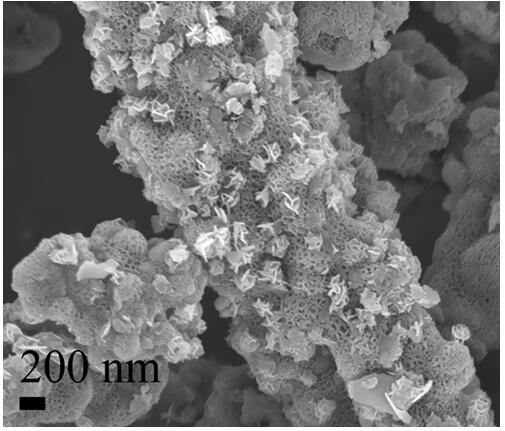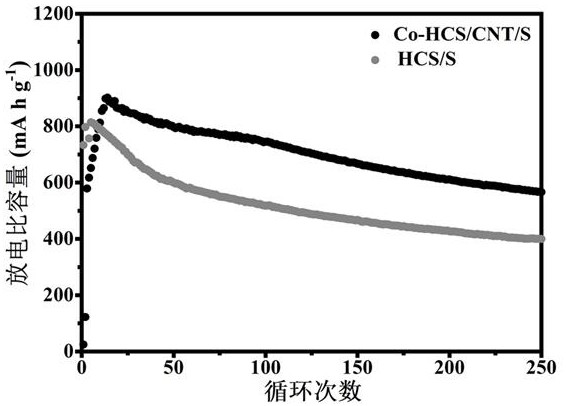Co-HCS/CNT/S composite lithium-sulfur battery positive electrode material and preparation method thereof
A positive electrode material and composite material technology, which is applied in the field of Co-HCS/CNT/S composite lithium-sulfur battery positive electrode material and its preparation, can solve the problems of poor battery cycle life, poor rate performance, and low sulfur utilization rate, etc.
- Summary
- Abstract
- Description
- Claims
- Application Information
AI Technical Summary
Problems solved by technology
Method used
Image
Examples
Embodiment 1
[0028] Example 1: A Co-HCS / CNT / S composite lithium-sulfur battery cathode material and its preparation method
[0029] Specifically include the following steps:
[0030] (1) Mix 3 mL tetrapropyl orthosilicate, 70 mL ethanol, 10 mL H 2 O and 3 mL, 5% (wt%) NH 3 ·H 2 O was stirred for 15 min; 0.4 g resorcinol, 0.56 ml, 37% wt% formaldehyde, 0.1 g PPy, 0.2 g Co(NO 3 ) 2 ·6H 2 O, stirred for 24 hours; centrifuged, washed, and dried.
[0031] The synthesis method of PPy is as follows:
[0032] 0.1 g methyl orange, 1.96 g FeCl 3 , 150 mL deionized water, 500 μL pyrrole monomer, magnetically stirred at room temperature for 24 h. Centrifuge, wash, and dry.
[0033] (2) Annealing in an argon atmosphere at 700°C for 5 hours to obtain SiO 2 @Co-HCS / CNT.
[0034] (3) SiO 2 @Co-HCS / CNT and 2 mol / L sodium hydroxide solution were mixed and allowed to stand for 36 hours, then dried after centrifugation. Co-HCS / CNT is obtained.
[0035] (4) Mix sulfur powder and Co-HCS / CNT at a m...
Embodiment 2
[0050] Example 2: A Co-HCS / CNT / S composite lithium-sulfur battery cathode material and its preparation method
[0051] Specifically include the following steps:
[0052] (1) Mix 2 mL tetrapropyl orthosilicate, 46.6 mL ethanol, 6.66 mL H 2 O and 2 mL, 5% wt% NH 3 ·H 2 O was stirred for 15 min; added 0.13 g resorcinol, 0.37 mL, 37% wt% formaldehyde, 0.2 g PPy, 0.13 g Co(NO 3 ) 2 ·6H 2 O, stirred for 24 hours; centrifuged, washed, and dried.
[0053] The synthesis method of PPy is as follows:
[0054] 0.1 g methyl orange, 1.96 g FeCl 3 , 150 mL deionized water, 500 μL pyrrole monomer magnetic stirring at room temperature for 24 hours; centrifuge, wash and dry.
[0055] (2) Annealing in an argon atmosphere at 700°C for 5 hours to obtain SiO 2 @Co-HCS / CNT.
[0056] (3) SiO2@Co-HCS / CNT and 2 moL / L sodium hydroxide solution were mixed and allowed to stand for 36 hours, then dried after centrifugation.
[0057] (4) Mix sulfur powder with Co-HCS / CNT at a mass ratio of 7:3. ...
PUM
 Login to View More
Login to View More Abstract
Description
Claims
Application Information
 Login to View More
Login to View More - R&D
- Intellectual Property
- Life Sciences
- Materials
- Tech Scout
- Unparalleled Data Quality
- Higher Quality Content
- 60% Fewer Hallucinations
Browse by: Latest US Patents, China's latest patents, Technical Efficacy Thesaurus, Application Domain, Technology Topic, Popular Technical Reports.
© 2025 PatSnap. All rights reserved.Legal|Privacy policy|Modern Slavery Act Transparency Statement|Sitemap|About US| Contact US: help@patsnap.com


